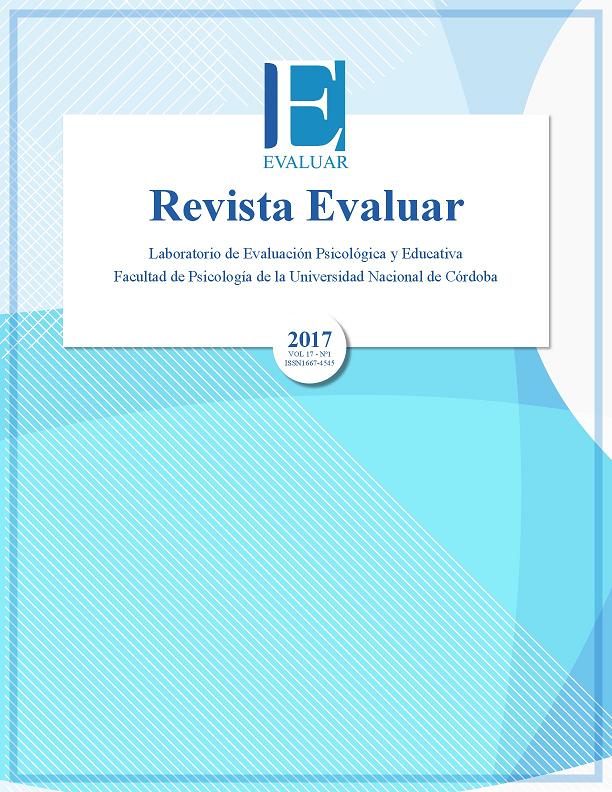Estandarización del Child Behavior Checklist para preescolares de población urbana de Argentina
DOI:
https://doi.org/10.35670/1667-4545.v17.n1.17075Keywords:
children, mental health, prevention, CBCLAbstract
Mental health problems in children can affect their ability to develop emotional and cognitive resources. An early diagnosis of these problems is an excellent prevention strategy; therefore, it is necessary to have validated instruments.
We proposed to standardize the Child Behavior Checklist (CBCL 1½-5) in its Spanish version for parents.
A methodological study was carried out on a sample of 541 preschool children from urban population of Argentina, n = 369 from the general population and n = 172 from a mental health clinical group. According to the results, the CBCL 1½-5 is appropriate to evaluate degrees of behavioral and emotional problems in early ages. The broad scales (total score, externalizing problems and internalizing problems) adequately discriminated between the clinical group and the general population group. The reliability of the instrument was corroborated by high degree of agreement between informants (parents), adequate values of internal consistency, high correlation values after 7 days (test-retest), and after 6 months (stability).
The standarized CBCL 1½-5 allows an early detection of behavioral and emotional problems, improving the diagnosisof mental health problems in children.
Downloads
References
Achenbach, T. M. (1992). Manual for the Child Behavior Checklist/2-3. Burlington, VT: University of Vermont, Department of Psychiatry.
Achenbach, T., & Rescorla, L. (2000). Manual for the Aseba Preschool Forms & Profiles. Burlington, VT: University of Vermont. Research Center for Children, Youth, & Families.
Achenbach, T. M., & Rescorla, L. (julio, 2004). Practical Applications of the Achenbach System of Empirically Based Assessment (ASEBA) for Ages 1.5 to 90+ Years. Trabajo presentado en la International Test Users’ Conference. ACER, Melbourn, Australia. Recuperado de http://research.acer.edu.au/research_conferenceITU_2004/2
Achenbach, T. M., Rescorla, L. A., & Maruish, M. (2004). The Achenbach System of Empirically Based Assessment (ASEBA) for ages 1.5 to 18 years. En Maruish M. E. (Ed.). The Use of Psychological Testing for Treatment Planning and Outcomes Assessment, 2, 179-213. Londres: Laurence Erlbaum.
Asociación Argentina de Marketing. (2010). Índice de Nivel Socioeconómico Argentino, Buenos Aires, Argentina.
Bologna, E. (2015). Estimación por intervalo del tamaño del efecto expresado como proporción de varianza explicada. Revista Evaluar, 14. Recuperado de https://revistas.unc.edu.ar/index.php/revaluar
Cárdenas-Castro, M. C., & Arancibia-Martini, H. A. (2014). Potencia estadística y cálculo del tamaño del efecto en G* Power: Complementos a las pruebas de significación estadística y su aplicación en psicología. Salud & Sociedad, 5(2), 210-224. Recuperado de http://revistas.ucn.cl/index.php/saludysociedad
Cervone, N., Samaniego, C., Luzzi, A. M., Slapak, S., Padawer, M., & Frylinztein, C. (agosto, 2003). Enfoque epidemiológico en una población clínica de niños escolarizados. Memorias de las X Jornadas de Investigación en Psicología, (pp 25-28). Facultad de Psicología, Universidad de Buenos Aires. ISSN 1667-6750.
Dougherty, L. R., Leppert, K. A., Merwin, S. M., Smith, V. C., Bufferd, S. J., & Kushner, M. R. (2015). Advances and directions in preschool mental health research. Child Development Perspectives, 9(1), 14-19. doi: 10.1111/cdep.12099
Egger, H. L., & Angold, A. (2006). Common emotional and behavioral disorders in preschool children: Presentation, nosology, and epidemiology. Journal of Child Psychology and Psychiatry, 47(3-4), 313-337. doi: 10.1111/j.1469-7610.2006.01618.x
George, D., & Mallery, P. (2001). SPSS for Windows step by step: A simple guide and reference. Boston, MA: Allyn and Bacon.
Hernández-Sampieri, R., Fernández-Collado, C., & Baptista-Lucio, P. (2006). Metodología de la Investigación. (4º ed.). México: McGraw-Hill.
IBM (2012). SPSS Statistics 21.0.0. [software de cómputo]. Recuperado de https://www-01.ibm.com/software/mx/analytics/spss/products/statistics
Ivanova, M. Y., Achenbach, T. M., Rescorla, L. A., Harder, V. S., Ang, R. P., Bilenberg, N., . . . Verhulst, F. C. (2010). Preschool psychopathology reported by parents in 23 societies: Testing the seven-syndrome model of the Child Behavior Checklist for ages 1.5-5. Journal of the American Academy of Child & Adolescent Psychiatry, 49(12), 1215-1224. doi: 10.1016/j.jaac.2010.08.019
Lecannelier, F., Pérez-Ewert, J. C., Groissman, S., Gallar-do, D., Bardet, A. M., Bascuñan, A., & Rodríguez, J. (2014). Validation of Child Behavior Inventory for Children ages 1½ to 5 years (CBCL 1½-5) at the Santiago de Chile City. Universitas Psychologica, 13(2), 491-500. doi: 10.11144/Javeriana.UPSY13-2.vici
Limberg, K., Gruber, K., & Noterdaeme, M. (2016). The German version of the Child Behavior Checklist 1.5-5 to identify children with a risk of autism spectrum disorder. Autism: The International Journal of Research and Practice, 21(3), 368-374. doi: 10.1177/1362361316645932
Lins, T., & Alvarenga, P. (2015). Controle psicológico materno e problemas internalizantes em pré-escolares. Psicologia: Teoria e Pesquisa, 31(3), 311-319. doi:10.1590/0102-37722015032092311319
Liu, J., Leung, P. W., McCauley, L., Ai, Y., & Pinto-Martin, J. (2013). Mother’s environmental tobacco smoke exposure during pregnancy and externalizing behavior problems in children. Neurotoxicology, 34, 167-174. doi: 10.1016/j.neuro.2012.11.005
Liu, J., Leung, P., Sun, R., Li, H.-T., & Liu, J.-M. (2012). Cross-cultural application of Achenbach System of Empirically Based Assessment: Instrument translation in Chinese, challenges, and future directions. World Journal of Pediatrics, 8(1), 5-10. doi: 10.1007/s12519-011-0329-x
Liu, J., Liu, X., Wang, W., McCauley, L., Pinto-Martin, J., Wang, Y., ... Rogan, W. J. (2014). Blood lead concentrations and children’s behavioral and emotional problems. JAMA Pediatrics, 168(8), 737. doi: 10.1001/jamapediatrics.2014.332
Martinez, C. (2009). Salud Mental en la infancia y adolescencia. En Organización Panamericana de la Salud, Salud Mental en la Comunidad, (pp. 231-244). Washington, D.C.: Serie PALTEX.
Molina, M. F., Calero, A., & Raimundi, M. J. (2014). Escala de Evaluación del Comportamiento del Niño en su versión para Padres (PRS): Adaptación para su uso en Buenos Aires. Revista Evaluar, 13. Recuperado de https://revistas.unc.edu.ar/index.php/revaluar
Müller, J. M., Averbeck-Holocher, M., Romer, G., Fürniss, T., Achtergarde, S., & Postert, C. (2015). Psychiatric treatment outcomes of preschool children in a family day hospital. Child Psychiatry & Human Development, 46(2), 257-269. doi: 10.1007/s10578-014-0465-3
Muratori, F., Narzisi, A., Tancredi, R., Cosenza, A., Calugi, S., Saviozzi, I., ... Calderoni, S. (2011). The CBCL 1.5-5 and the identification of preschoolers with autism in Italy. Epidemiology and Psychiatric Sciences, 20(04), 329-338. doi: 10.1017/s204579601100045x
Pandolfi, V., Magyar, C. I., & Dill, C. A. (2009). Confirmatory factor analysis of the Child Behavior Checklist 1.5-5 in a sample of children with autism spectrum disorders. Journal of Autism and Developmental Disorders, 39(7), 986-995. doi: 10.1007/s10803-009-0716-5
Pihlakoski, L., Sourander, A., Aromaa, M., Rautava, P., Helenius, H., & Sillanpää, M. (2006). The continuity of psychopathology from early childhood to preadolescence. European Child & Adolescent Psychiatry, 15(7), 409-417. doi: 10.1007/s00787-006-0548-1
Predescu, E., Şipos, R., Dobrean, A., & Miclutia, I. (2013). The discriminative power of the CBCL 1.5-5 between autism spectrum disorders and other psychiatric disorders. Journal of Cognitive & Behavioral Psychotherapies, 13(1), 75-87. ISSN: 2068-7621
Rescorla, L. A. (2005). Assessment of young children using the Achenbach System of Empirically Based Assessment (ASEBA). Mental Retardation and Developmental Disabilities Research Reviews, 11(3), 226-237. doi: 10.1002/mrdd.20071
Rescorla, L. A., Achenbach, T. M., Ivanova, M. Y., Har-der, V. S., Otten, L., Bilenberg, N., ... Verhulst, F. C. (2011). International comparisons of behavioral and emotional problems in preschool children: Parents’ reports from 24 societies. Journal of Clinical Child & Adolescent Psychology, 40(3), 456-467. doi: 10.1080/15374416.2011.563472
Rivas, M. S., Vázquez, N., & Samaniego, V. C. (2011). La salud mental de los más pequeños, su relación con la salud mental de sus padres. Memorias de las XVIII Jornadas de Investigación en Psicología. Facultad de Psicología, Universidad de Buenos Aires. Recuperado de http://jimemorias.psi.uba.ar
Samaniego, V. C. (2004). Prevalencia de trastornos psíquicos en población escolar de 6 a 11 años de edad. Memorias de las XI Jornadas de Investigación en Psicología. Facultad de Psicología, Universidad de Buenos Aires. Recuperado de http://jimemorias.psi.uba.ar
Samaniego, V. C. (2005) Problemas comportamentales y sucesos de vida en niños de 6 a 11 años de edad. Revista Psykhe, 14(2), 97-108. doi: 10.4067/s0718-22282005000200008
Samaniego, V. C. (2008). El Child Behavior Checklist: Su estandarización en población urbana argentina. Revista de Psicología Universidad Católica Argentina, 4(8), 113-130. Recuperado de http://www.uca.edu.ar/index.php/site/index/es/uca/facultad-de-psicologia-y-psicopedagogia/publicaciones/revista-de-psicologia
Samaniego, V. C. (2012). Problemas comportamentales y emocionales y tolerancia parental en niños pequeños, ¿estabilidad o cambio? Memorias de las XIX Jornadas de Investigación en Psicología. Facultad de Psicología, Universidad de Buenos Aires. Recuperado de http://jimemorias.psi.uba.ar
Samaniego, V. C. (2015). Factores asociados a la Salud Mental Infantil: Diferencias entre padres y madres en sus interacciones con los niños. Memorias de las XXII Jornadas de Investigación en Psicología. Facultad de Psicología, Universidad de Buenos Aires. Recuperado de http://jimemorias.psi.uba.ar
Schu, M., Zan, & Vázquez, N. (junio, 2011). Motivos de consulta infanto-juveniles: Diferencias según variables sociodemográficas. Trabajo presentado en el XVIII Congreso Latinoamericano de FLAPIA y XV Congreso de AAPI. Buenos Aires, Argentina.
Skovgaard, A., Houmann, T., Landorph, S., & Christiansen, E. (2004). Assessment and classification of psychopathology in epidemiological research of children 0-3 years of age. European Child & Adolescent Psychiatry, 13(6), 337-346. doi: 10.1007/s00787-004-0393-z
Skovgaard, A. M., Olsen, E. M., Christiansen, E., Houmann, T., Landorph, S., & Jørgensen, T. (2008). Predictors (0-10 months) of psychopathology at age 1½ years–a general population study in The Copenhagen Child Cohort CCC 2000*. Journal of Child Psychology and Psychiatry, 49(5), 553-562. doi: 10.1111/j.1469-7610.2007.01860.x
Slapak, S., Cervone, N., Luzzi, A. M., & Samaniego, C. (2002). Aplicación del enfoque epidemiológico a una población clínica de niños. Psico-USF, 7(1), 67-76.
Downloads
Published
How to Cite
Issue
Section
License
Copyright (c) 2017 Natalia Vázquez, Virginia Corina Samaniego

This work is licensed under a Creative Commons Attribution 4.0 International License.
Revista Evaluar aplica la Licencia Internacional de Atribuciones Comunes Creativas (Creative Commons Attribution License, CCAL). Bajo esta licencia, los autores retienen la propiedad de copyright de los artículos pero permiten que, sin que medie permiso de autor o editor, cualquier persona descargue y distribuya los artículos publicados en Evaluar. La única condición es que siempre y en todos los casos se cite a los autores y a la fuente original de publicación (i.e. Evaluar). El envío de artículos a Evaluar y la lectura de los mismos es totalmente gratuito.




_(3).jpg)



.jpg)



